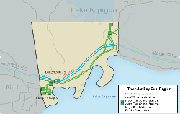Thunder Bay
An Integrated Regional Resource Plan was released for the Thunder Bay sub-region in December 2016.
Area Overview
 In addition to being the largest population centre in Northwest Ontario, the Thunder Bay area hosts several industrial facilities, including pulp and paper and primary resource industries. Electricity demand in this area peaks during the winter months, with historical peak demand ranging from around 350 MW to 400 MW.
In addition to being the largest population centre in Northwest Ontario, the Thunder Bay area hosts several industrial facilities, including pulp and paper and primary resource industries. Electricity demand in this area peaks during the winter months, with historical peak demand ranging from around 350 MW to 400 MW.
For regional planning purposes, the Thunder Bay sub-region extends from the north shore of Lake Superior to the southern shore of Lake Nipigon, and from the Township of Nipigon to Kakabeka Falls. In addition to the City of Thunder Bay, several municipalities are located within this area, as well as the Fort William and Red Rock First Nations.
Historical Context
In 2007, the OPA (now the IESO) examined the supply adequacy of the Thunder Bay area in anticipation of the shutdown of local coal-fired generation as part of the Integrated Power System Plan. Since that time, the IESO has been monitoring supply and demand in the area, to ensure that a reliable supply of electricity is maintained. To date, the area's supply has been adequate and no reinforcement has been necessary.
Community Engagement
The IESO engages with local and regional communities to seek input to help inform regional planning activities. An Integrated Regional Resource Plan (IRRP) from the latest Thunder Bay planning cycle was finalized in 2016.
Regional Planning Status
While electricity demand has decreased in recent years, there is potential for renewed growth in the Thunder Bay sub-region associated with forecast mining and other industrial development throughout the Northwest, due to the area's position as a regional hub.
Regional planning will provide options to address the potential for demand growth, considering both the limits on the existing supply to the area, and opportunities for coordinating new demand and supply options.
Documents referenced on this page, but not posted, can be obtained by contacting customer.relations@ieso.ca with a link to the web page that lists the document and advise whether it needs to be provided in an accessible format. Please allow a minimum of one business day for a response.
IRRP Working Group - Next Steps
A Working Group consisting of the local distribution companies in the region, the local transmitter and the IESO will make recommendations to address the longer-term needs in the region based on planning criteria and consideration of community input.
The Working Group currently consists of representatives from Thunder Bay Hydro, Hydro One Distribution and Transmission and the IESO.


